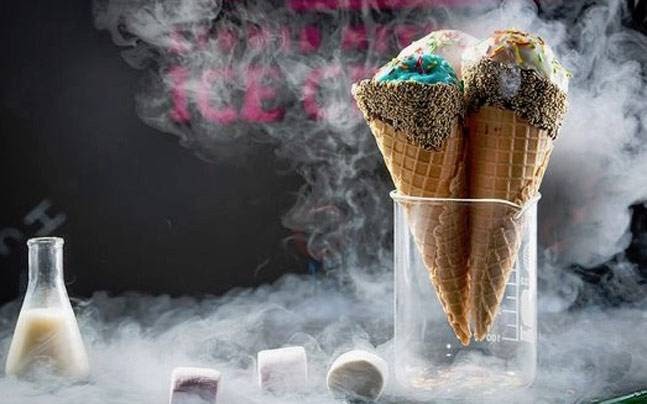TN makes it mandatory for food stalls and eateries to ensure liquid nitrogen is fully evaporated from the food or drink before it is served.

Recently, the video of a young boy screaming in pain after consuming a “smoking” biscuit went viral on social media platforms.
Some claimed that the incident occurred in Chennai. Others said the incident was from Karnataka’s Davangere.
However, after this video went viral, several doctors took to X (formerly Twitter) and other social media platforms to caution parents on the dangers of liquid nitrogen.
The Tamil Nadu government on Thursday, 25 April, warned food business operators against using liquid nitrogen for direct consumption along with food items like biscuits, ice creams, and wafers.
“Liquid nitrogen should be fully evaporated from the food or drinks before being served,” the order stated.
Doctors South First spoke to agreed that this was a welcome move, and said other states must follow suit.
Liquid nitrogen is a cryogenic liquid used in food products mainly for its rapid freezing abilities and for creating dramatic visual effects, like vapour clouds.
Noted neurologist from Apollo Hospitals Dr Sudhir Kumar explained: “This is a liquid that has a very low boiling point: -196° Celsius. It exists as a gas at room temperature.”
This incident occurred at an exhibition near Aruna talkies, Dhavangare.
Liquid Nitrogen converts into Ice form immediately.
Excess amount of Liquid Nitrogen poured and the Ice cream swallowed by this small boy got expanded inside the Lungs as a Big Ice cream. pic.twitter.com/1tZSRZQS7o— uttam mishra (@uttamprithvi) April 24, 2024
Liquid nitrogen is used to quickly freeze foods, which can be beneficial for preserving the texture and flavour of items such as ice cream.
Meanwhile, due to its extremely low temperature and dense vapour, chefs use liquid nitrogen to create a dramatic mist effect around dishes, enhancing the dining experience.
Explaining the use of this in some popular restaurants and pubs, David John — a chef at one of the restaurants in the Koramangala area of Bengaluru — told South First: “Liquid nitrogen can be used to make unique and innovative dishes like nitrogen-infused cocktails or popcorn that, when eaten, allows diners to breathe out a vapour. It has even reached the street where even pan is served with this.”
Dr Rajeev Jayadevan, a noted gastroenterologist from Kochi, told South First, “Liquid nitrogen is a dangerous substance to work with because it has an extremely low boiling point of -196° C. This temperature is far colder than the human body can tolerate.”
He explained: “If something at that temperature comes into contact with the human body, it causes severe cryogenic burns and tissue damage, irrespective of if it is splashed on the skin or eye or taken internally.”
He explained that due to it being colourless, tasteless, and odourless, the person consuming it wouldn’t even know until tissue damage sets in.
Kumar explained that accidental contact exposure to liquid nitrogen could cause burns and frostbite, and accidental inhalation or ingestion (swallowing) could cause asphyxiation (choking) or airway/gastric perforations, respectively, due to the extreme cold.
“Many cases of several injuries from ingestion of foods and beverages containing liquid nitrogen have been reported,” he noted.
Liquid nitrogen is sometimes seen being used at food stalls and amusement centres because of its dramatic presentation of smoke as well as its rapid cooling effect on whatever food substance it’s poured on.
Jayadevan explained that handling this dangerous substance required special training, protective equipment, and a list of precautions.
He noted that all of this could be cumbersome to implement or enforce at each food outlet using liquid nitrogen.

The abdomen of a 13-year-old boy was severely distended. (A) Front view. (B) Side view. (https://e-ce.org/journal/view.php?doi=10.5946/ce.2017.178)
“Remember that viral video showing the child falling ill after consuming the smoky substance? It was wrongly stated on social media that the child died. Fact check reports have since confirmed that the child is indeed alive,” he said.
“However, this does not mean that this practice should continue unchecked. And without examining the child, it is impossible to determine what damage has occurred,” he added.
The real danger comes when, after pouring liquid nitrogen onto the food substance, it is consumed before the liquid nitrogen is fully evaporated.
This gives a chance for this liquid to enter the human body and cause major damage. This might have happened in the child’s case, he surmised.
Jayadevan said that there had been case reports published about large holes (perforations) occurring in the stomach after drinking such preparations, which required major surgery to save the patient’s life.
“A case of pneumoperitoneum — massive amounts of gas in the abdominal cavity — was also reported. A man required amputation of his leg for massive tissue damage after he stepped on liquid nitrogen,” he said.
While the doctors stressed that consumption of such material — regardless of temptation or peer pressure — should be avoided in the interest of safety, the Tamil Nadu government has warned food business operators against using liquid nitrogen for direct consumption with food items like biscuits, ice creams, and wafer biscuits.
It has also said liquid nitrogen should be fully evaporated from the food or drinks before the item is served.
It has directed designated officers and food safety officers to take stringent action under the Food Safety and Standards Act of 2006 against any violations by food business operators using liquid nitrogen for direct consumption with food items.
“Liquid nitrogen (INS 941) is permitted only as a processing aid, as contact freezing and colouring agents (substances that can cause rapid freezing on contact with food) as per Appendix C-S.No.9 under processing Categories in the product category dairy-based desserts — ice cream,” a release said.
The residual level (mg/Kg) is as per Good Manufacturing Practice (GMP) in the final product prepared as per Appendix C of the Food Safety and Standards (Food Products Standards and Food Additives) Regulation of 2011 under Table 9 in the use of processing aids in food products.
Also, nitrogen can be used as packing gas and freezing agent only as per the Food Safety and Standards (Food Products Standards and Food Additives) Regulation of 2011, the release explained.
(Edited by Arkadev Ghoshal)

Jul 26, 2024

Jul 26, 2024

Jul 26, 2024

Jul 26, 2024

Jul 26, 2024

Jul 25, 2024